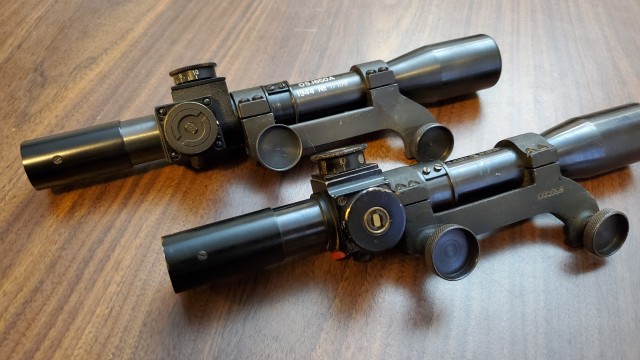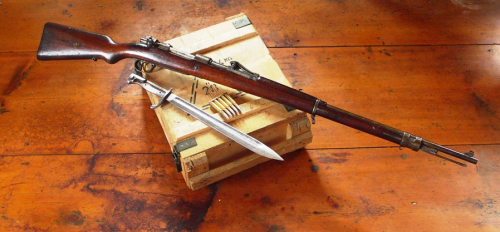#bolt action
TheGewehr 98(abbreviatedG98,Gew 98orM98) is a German bolt action Mauser rifle firing cartridges from a 5 round internal clip-loaded magazine that was the German service rifle from 1898 to 1935, when it was replaced by the Karabiner 98k. It was hence the main rifle of the German infantry during World War I. The Gewehr 98 replaced the earlier Gewehr 1888 rifle as the German service rifle. The Gewehr 98, and especially its action, also directly influenced the design of many other military rifles of the era such as the M1903 Springfield, the M1917 Enfield and the Arisaka.
Post link

System Mauser










More Bock Mauser









More details of the Bock Mauser it has Greener Style Safety, to use with the scope.








So the bolt in the Bock Mauser is not matching to the gun. It is actually form a WW2 K98 and has Waffen Stamps on it. I think that the rifle must have been brought back by an American GI after WW2 and a gunsmith later converted the bolt handle as well as engraved it. The scroll work theme also doesn’t match the rest or the rifle. And although it is nice, the craftsmanship is not up to par with Otto Bocks work. I also cross reference any pictures of Bock Mauser with spoon handle bolts and it doesn’t match up. Sad as it maybe, at least it was not run over by a Sherman tank.










A look at the inside of the Bock Mauser. It is interesting that the rifle has it own serial number and that there is another serial number that all the small parts are matched to. But then the stock is number to the gun and not to the steel parts.










Pick up a very fine Mauser Hunting Rifle made by the Famous Otto Bock in his very own 9.3x62. It was probably made at the turn of the century for someone in the Bavarian Royal Court. As indicated by the, “Koniglicher Hoflieferant,” ingraved on the right side of the barrel. Which translates to, “ Royal Court Suppler or Suppler to the Royal Court.” The top of the barrel states that Krupp.Stahl or Krupp Steel was used in the making of this rifle, which was the best steel in the world at the time. An on the right hand side, the name of the gunsmith Otto Bock of Berlin.
The bolt unfortunately doesn’t match the gun and the original scope has been lost to time. But over all a beautiful Hunting Rifle and I am glad to have it.










More M28/30


Guns of Simo Hayha, The White Death.
Westinghouse M91 & Finnish M28/30





Springfield Battle Rifles










More 1903








Springfield M1903, made in 1918 rebarreled 1942










More Krag








Krag Model of 1898 made in 1903










More of the Type 38








So the Type 38 that bought recently is a, “Numbers Matching,” gun. Except for the dust cover, those never seam to match.
“Because Japanese Soldiers throw them away, I don’t care about what the internet says, I happen to have spare one and put it on this rifle, fight be…”
Anyways this is important, because these guns where still hand fitted. The only thing about it is that the gentleman that sold it to me said it was mismatched.
Here is something to remember with the Arisaka. They don’t have the same numbering convention as European firearms. Where the gun would be serialized and the last two or four digits of the serial number would be stamped on all the parts.
The Japanese would serialized the Rifle with a set number for book keeping purposes, for the Japanese Imperial Military, Government, and who ever else need to know how many rifles where being made. But then would number the gun to itself, by marking a Kanji followed but two to four numbers. They would then number most major parts such as the bolt, rear sight latter, tang, etc to that set number.
The Japanese, would change this numbering convention, with the 20th or 25th type (variation) I can’t remember exactly. The Tokyo Arsenal would change it post serial number 2,014,000. To a European numbering convention, where the last three number of the main serial number would be stamped on all major parts, such as the bolt.










It been a while…
Anyways, I decided that I wanted to replace my old Type 38 Arisaka which was a “school,” or training rifle with a nicer example. Which was an ordeal in of itself, but I was able to find one in excellent condition.
So here is my new Type 38, I will post more pictures later.


American Great War rifles, the Eddystone M1917 and the Springfield 1903.









Eddystone M1917, made in 1918.
The Rifle of Alvin York and The American Expeditionary Force in France during the Great War. 3 out of every 4 Rifles where M1917s.





The No. 32 scope Mk 2 & Mk 3








More No 4 Mk 1 (T)






No 4 Mk 1 (T) Snipers
The Universe is a strange thing and guns happen to find me. I never thought I would be able to find and original No 4 Mk 1 (T). So I put in the leg work to restore a sportizered one was was petty happy with it.
Then one walks in the door…
Interesting to compare a rifle built by Holand & Holand and one by Parker Hale.


Japanese Arms of World War Two


